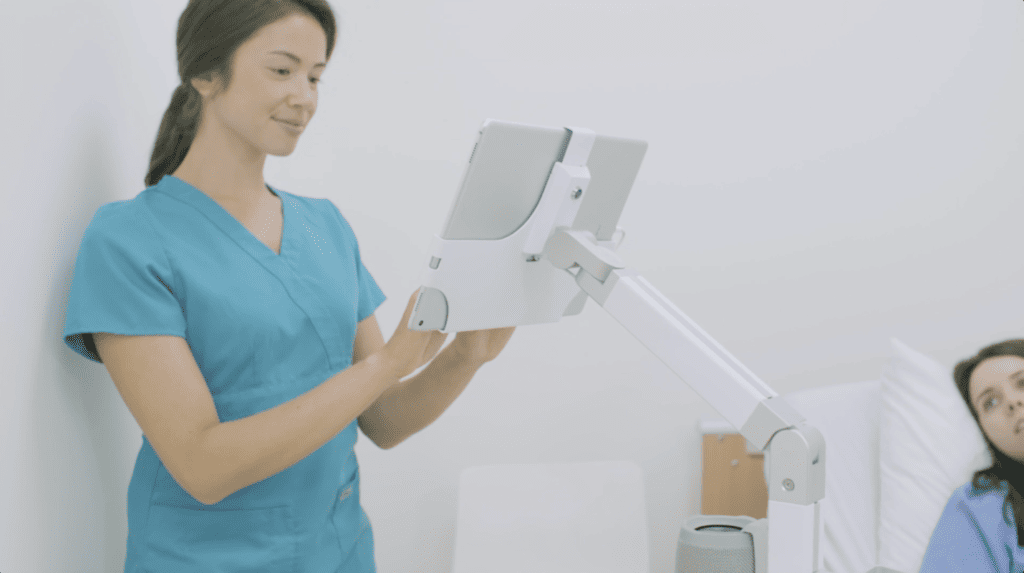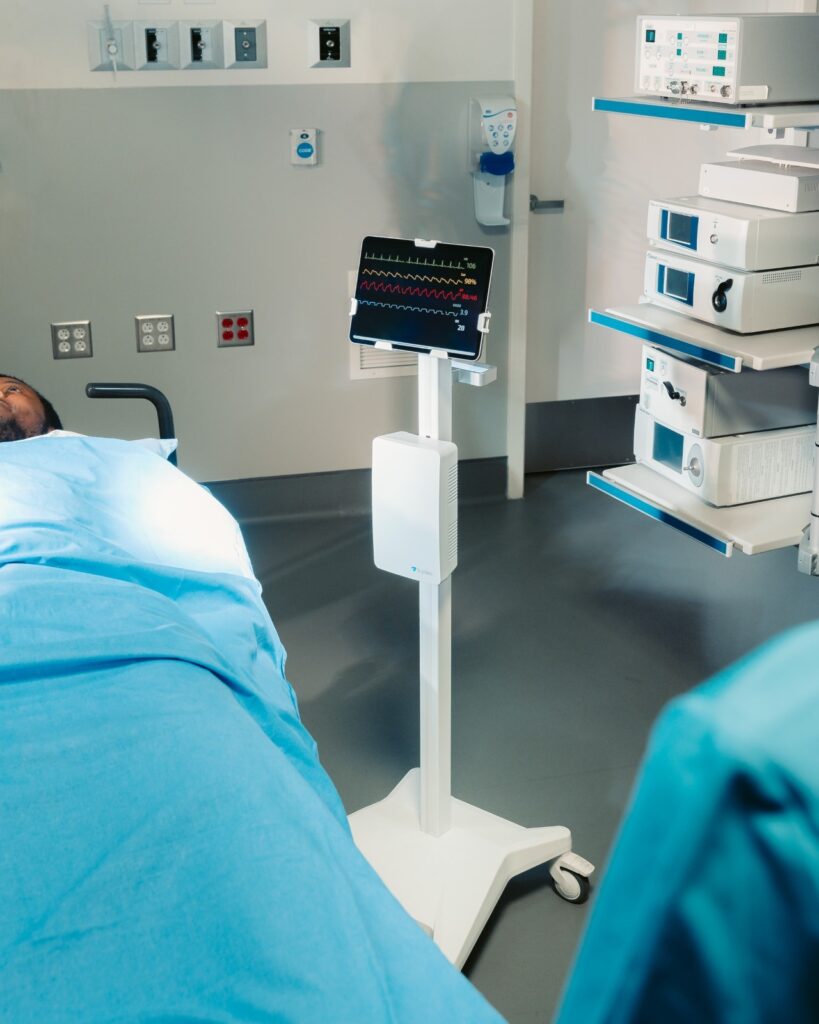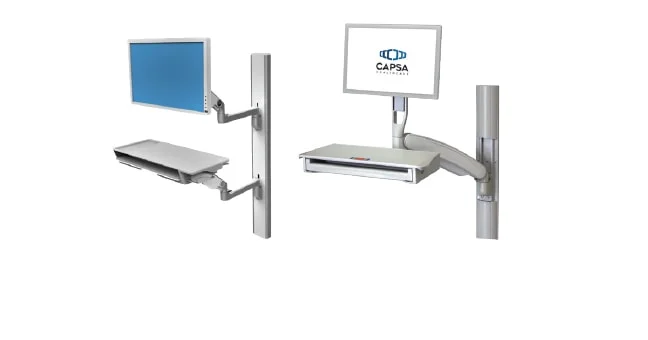
In the healthcare landscape fraught with staffing shortages and evolving challenges, virtual nursing is a promising solution to address the pressing need for enhanced patient care. The question may arise: why turn to “virtual” nurses when the scarcity of physical nurses at the bedside is already a concern? However, it’s precisely due to this scarcity that their presence becomes even more imperative.
By collaborating with in-person healthcare teams, virtual nurses play a supportive role that alleviates the demanding workload and enhances patient and onsite nursing staff satisfaction levels. It also offers experienced nurses an avenue to extend their careers in positions that involve less physical strain, all while making the most of their extensive knowledge and expertise.
But what exactly is virtual nursing?
In the past decade, the role of nurses has transcended traditional phone triage, giving rise to the concept of “virtual nursing.” It is a form of nursing care that uses technology to provide virtual care. Virtual care integrates technologies, such as mobile nursing carts, digital care plans, and remote patient monitoring, to offer a wide range of health services remotely. As a result, the reach of nursing staff extends beyond the traditional confines of bedside care, effectively granting more patients access to high-quality medical care.
So how does virtual nursing disrupt the established norms of patient care administration? Read on to find out.
Accessibility and continuity of care are often significant challenges for patients in traditional health systems. The National Center for Health Statistics reports that 88.1% of people in the United States did not have a usual place to go for medical care from 2019 to 2021.
Inaccessibility could stem from geographical constraints, mobility issues, or the scarcity of healthcare providers. Continuity of care presents additional challenges, as it is often disrupted by transfers between care teams or when patients cannot visit health facilities regularly.
Virtual nursing introduces a solution to these obstacles, offering a care delivery model that prioritizes patient experience and satisfaction.

Remote patient monitoring is a technology that allows nurses to monitor patients’ health data from a distance. Data, such as vital signs, can be collected and sent to the care team in real-time via devices such as:
Patients with chronic health conditions often need long-term monitoring. Telemedicine enables providers to check in on patients through remote patient monitoring devices, such as apnea monitors, blood glucose meters, and fetal monitors. These tools enhance continuity of care by allowing you to track patient progress seamlessly, adjust care plans when necessary, and intervene promptly when the patient’s condition changes.

Virtual consultations are medical appointments conducted through a digital platform, negating the need for physical meetings. According to a scholarly journal of the American Nurses Association, “Telehealth nurses care for patients in intensive care and telemetry units from distant command centers where they can consult with providers and provide management and direction as needed. Some telehealth nurses function as “telepresenters,” working in the same room with patients who are participating in telehealth consultations with healthcare providers who are physically located elsewhere. They can also provide nursing care for patients at a distance relying solely on audio and video modalities.”
These consultations can spare patients the burden of extra transportation expenses and anxiety associated with traveling to different locations by enabling them to confer with virtual nurses within their own medical facility. You can also use virtual consultations for initial patient assessments or expert consultations for complex cases from specialists in different locations.
Telemedicine workstations are one way that hospitals can offer virtual consultations. With the use of the Trio Telemedicine Workstation, you can:
The Trio Telemedicine Workstation is a hospital cart that streamlines virtual medical care and diagnostics. It enables doctors to connect with remote patients through video, using diagnostic tools for faster and more accessible healthcare regardless of location.
By enabling virtual consultations, the workstation serves as a vital tool to bridge the accessibility gap in healthcare. The elimination of physical distance barriers and the flexibility in appointment scheduling significantly heightens healthcare availability.
Moreover, this approach guarantees uninterrupted medical attention, empowering patients to consult their healthcare providers despite physical constraints that may inhibit visits to healthcare facilities.
Chronic care management involves the ongoing care and support of patients with chronic conditions. Virtual platforms — such as remote patient monitoring systems and online patient portals — allow you to manage these conditions efficiently and effectively.
Healthcare organizations can manage various chronic conditions through these platforms, including diabetes, hypertension, and heart disease. With virtual platforms, you can use patient data to:
This virtual approach to chronic care management enhances accessibility by offering patients constant connection and support. It also allows for uninterrupted monitoring and management of chronic conditions by the same nurse, ensuring continuity of care.
Virtual nursing provides the platform and resources for effective patient education and self-management.
For example, you can use virtual resources like educational videos, online forums, and digital care plans to educate patients about their conditions, treatments, and care plans. These resources can also help patients develop skills for effective self-management, such as medication management, symptom management, and lifestyle changes.
Virtual nursing not only empowers patients to take charge of their health but also improves the quality of care. Patient engagement and satisfaction will increase as patients feel more involved and in control of their health care.
Efficiency and resource allocation are vital aspects of effective healthcare delivery:
So, what are some telenursing advantages to improving efficiency and resource allocation?
Remote patient monitoring reduces the need for unnecessary hospital visits and admissions, saving both time and resources. Virtual consultations can additionally reduce patient wait times and increase the number of patients seen per day.
Regarding resource allocation, virtual nursing assistants can alleviate the workload of onsite nursing staff, allowing them to focus on more critical tasks like direct patient care.
Thus, virtual nursing advantages include:
As per the National Council of State Boards of Nursing, “the value of telehealth to the patient and healthcare settings is increased when the care is provided by a skilled, empathetic nurse prepared to deliver nursing care through technologies.”
Geographical barriers, such as physical distance or lack of transportation, frequently prevent patients from accessing sufficient healthcare services.
Virtual nursing can help overcome these geographical barriers by providing healthcare services to patients in remote areas. Similarly, virtual nursing units can provide specialist care to patients who otherwise would not have access to such services.
By overcoming common geographical barriers, virtual nursing can enhance healthcare accessibility and ensure continuity of care. It can also improve patient satisfaction as patients can access quality healthcare services regardless of location.
 In the era of digital healthcare, ensuring patient safety and privacy becomes even more critical. Patient safety involves preventing errors and adverse events in
In the era of digital healthcare, ensuring patient safety and privacy becomes even more critical. Patient safety involves preventing errors and adverse events in
healthcare, while privacy involves protecting patients’ identification and personal health information (PHI)
Virtual nurse technology employs various measures to ensure patient safety and privacy through:
How can you optimize patient safety and privacy in virtual nursing? Regularly update your systems to prevent security breaches, train your staff on data privacy practices, and use encrypted communication channels for patient interactions.
Virtual nursing complies with ethical and legal standards by ensuring patient safety and privacy. It also builds trust with patients, thus enhancing their comfort and satisfaction.
Virtual nursing holds immense promise in transforming healthcare delivery, improving patient outcomes, and enhancing healthcare accessibility. By collaborating with in-person healthcare teams, virtual nurses alleviate workloads, extend the reach of nursing staff, and provide high-quality care through technology such as remote patient monitoring and virtual consultations.
If you are looking to integrate virtual nursing into your healthcare organization, consider partnering with Capsa Healthcare. As a global leader in healthcare solutions, we offer innovative products, such as virtual care carts and remote monitoring carts, to streamline your virtual nursing program, enhance workflow efficiency, reduce provider burnout, and improve patient care. View our virtual care carts today to see how you can transform your healthcare delivery with virtual nursing.